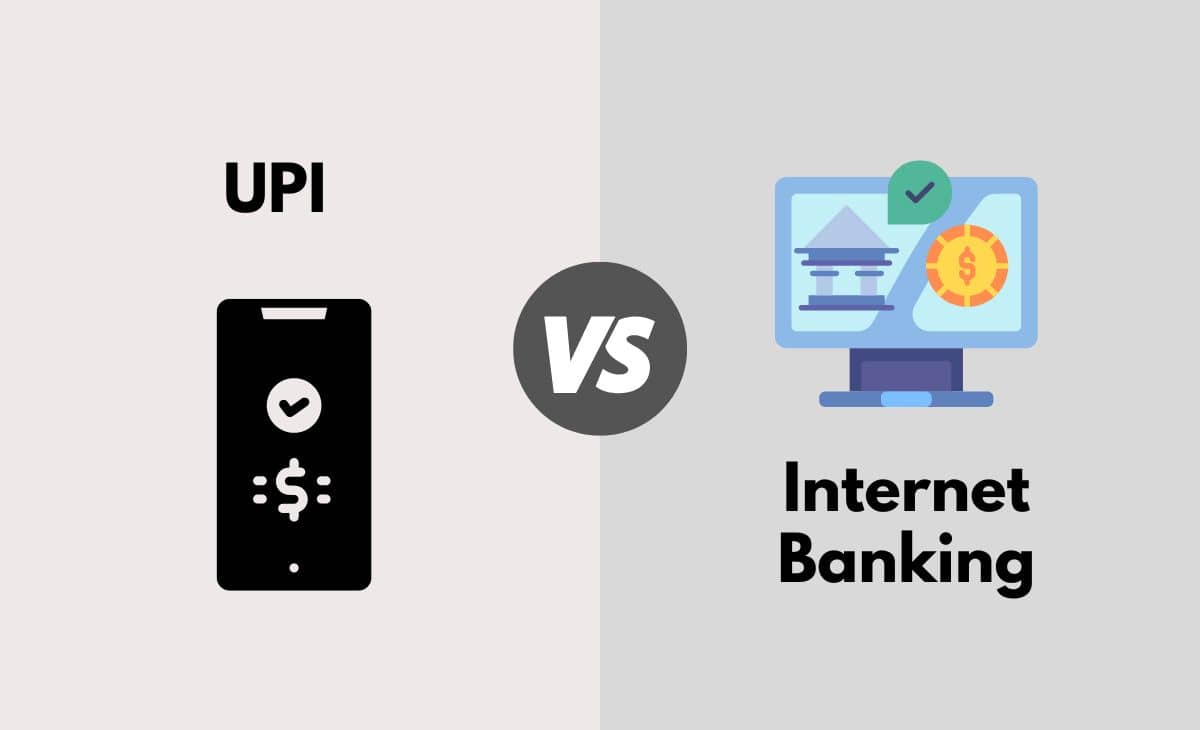Introduction
Unified Payment Interface (UPI) and Internet Banking are two of the most commonly used banking tools that make it easier for the user to perform different baking operations through the Internet. Both UPI and internet banking are used as instant payment systems but require different levels of input to complete the transaction. UPI only requires the payee's Virtual Payment Address (VPA), while Internet Banking asks for the beneficiary's bank account details. Today, more and more people are opting for UPI over Internet Banking because of its ease of access and less chance of transaction error. However, Internet Banking is required to perform certain banking operations where UPI is powerless.
UPI vs Internet Banking
The main difference between UPI and internet banking is that UPI is mainly used to transfer funds (peer-to-peer and merchant payments) using the various mobile apps that offer this service. While internet banking offers funds transfer services along with other banking options such as loan applications, credit card applications, and opening a fixed deposit account.
Difference Between UPI And Internet Banking In Tabular Form
| Parameter of Comparison | UPI | Internet Banking |
| Speed of Transaction | The average number of customer touch inputs to complete a transaction is 6. | The average number of customer touch inputs to complete a transaction is 50 |
| Cost of Funds transferred | No additional amount is charged. | A small commission is charged per transaction (usually Rs.5 to Rs.15). |
| Banks offering services | 29 banks. | Almost all banks |
| Beneficiary additions | Only the beneficiary's virtual payment address (VPA) is required. | Details (such as bank account number and IFSC code) are required. |
What is UPI?
Unified Payment Interface (UPI) is an instant real-time online payment system that allows instant transfer of funds from one bank account to another. This system is capable of managing transactions of different bank accounts through a single mobile application.
A VPA (Virtual Payment Address) must be created by the user in order to access the services offered by UPI. This VPA is linked to your bank account and represents your financial address. Therefore, the user does not have to enter all his bank account details, such as account number or IFSC code, each time he wants to avail of any of UPI's services once the VPA is linked to his bank account.
UPI incorporates 2-factor authentication, which complies with regulatory guidelines, and this is what makes this service so secure.
Some of UPI's key features are:
- You can access UPI's services at any time, as the platform is completely digital.
- Funds transfers are instant and, therefore, much faster than conventional methods such as NEFT.
- Different bank accounts are accessible using a single mobile application.
- Use the Mobile Banking Personal Identification Number (MPIN) to confirm each transaction as part of 2-factor authentication.
- Transactions can be made using a scannable QR code with a VPA attached.
What is Internet Banking?
Internet banking (or e-banking) is a service offered by banks and financial institutions that allows customers to access banking services more easily via an online platform. However, to make use of this provision, the customer must register for internet banking with the respective bank.
Since a customer's online banking account contains their vital financial information, security is of the utmost importance. Therefore, online banking platforms use two types of security methods, PIN/TAN and signature-based online banking. A PIN is used for easy access, and TANs are one-time passwords that securely approve transactions. Signature-based online banking refers to online banking where all transactions are digitally signed and encrypted. S
Some of the main features of internet banking are:
- Payment for services such as mobile devices or electricity bills (merchant payments), and fund transfers can be done easily.
- The user can open a term account without physically going to the bank.
- Services such as ordering a cheque book are integrated.
- User can download account statements.
- Facilitates loan and credit card applications.
Major Differences Between UPI And Internet Banking In Points
- UPI does not require the addition of beneficiaries to transfer funds, only their virtual payment address (VPA) is sufficient. To execute a transaction via Internet Banking, beneficiary details, including bank account number and IFSC code, are required; however, this does not have to be repeated for each transaction once the beneficiary has been added.
- UPI can only be accessed through mobile apps that offer this service. In contrast, you can access internet banking through the website or mobile app of that particular bank.
- Transactions made through UPIs are currently free. However, banks consider inducing a small fee on each transaction. On the other hand, internet banking services charge Rs.5 to Rs.15 per transaction.
- Internet banking offers a wide range of services, such as loan applications, credit card applications, and opening a term account. While UPI is used to find jobs related to resettlement.
- UPI has a very high success rate, while internet banking has a 10% lower success rate than the former.
Conclusion
UPI and Internet Banking are banking tools that make it easier for the customer to perform various banking transactions using the Internet. Both are well-versed in different ranges of operations. However, UPI and Internet Banking allow the user to perform online transactions instantly from any other bank account. One of them is considered a very secure method of performing banking services.
References
- http://paytm.com
- http://livemint.com

